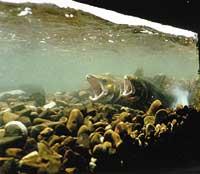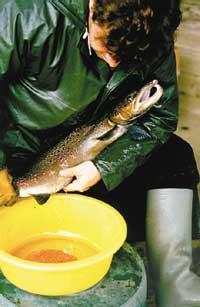Salmon born and died in the same stream
Salmon is a good and appreciated migratory fish of the family Salmonidae. The particularity is that after a long trip in the sea, it returns to the river of origin to reproduce and die.

The season of fertilization usually lasts between December and January and usually salmon females reproduce only once throughout life. Salmon reproduce in shallow areas of pebbles. The females with their tails move the stones and make a brush under the stone. The larva embryonic phase lasts approximately three months, until March. The main risk at this stage is that the particles found in skiing in the water fill the brush and choke the eggs, treading tractors and mountaineers.
Three months later, the fry leaves the stones and begins to spread around. In the beginning they are directed to the currents, but as they grow, when they need more space, they extend to other places.

According to the growth, after one or two years they head to the sea to start a journey from six months to three years. The salmon that travel further up reach western Greenland. For their part, the fites that get quite fat, reach sexual maturity when they are close to Ireland and have no time to reach Greenland. They do not eat anything during the whole turn. They use the smell to know in which mouths they have to access the breeding place.
Of the five salmon returning to Sarrakaria, four are young salmon traveling to Ireland. The first to climb in Sarrakaria in spring are the oldest salmon, with trips in the sea between two and three years. The climb is interrupted by the arrival of the low flows of August, but after the summer break, the youngest salmon continue their ascent with the first floods of autumn.





